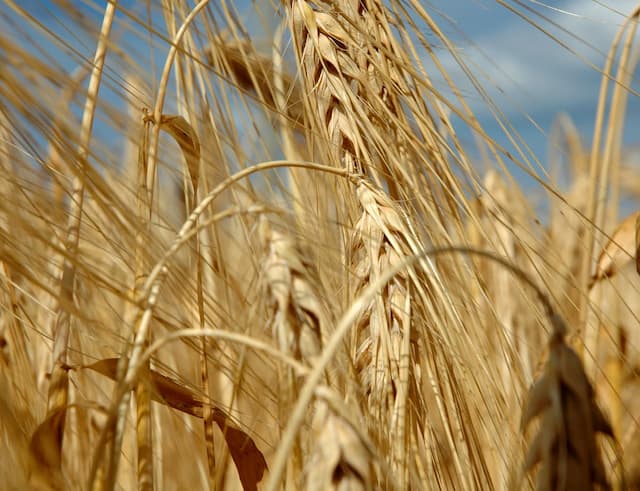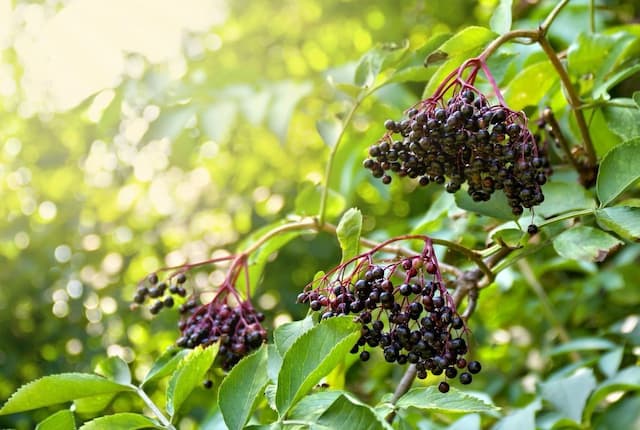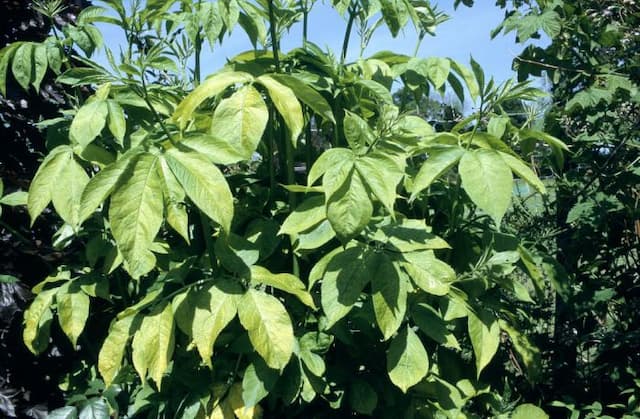Chinese snowball Viburnum hupehense

ABOUT
The Viburnum hupehense, commonly known as the Hubei viburnum, is a deciduous shrub that is known for its ornamental qualities. This plant typically displays a rounded habit with a lush, dense foliage that gives it a robust and full appearance. The leaves of the Hubei viburnum are ovate to elliptic in shape, with a slightly serrated margin and a glossy, dark green color that sometimes turns reddish-purple in the fall, adding a touch of autumnal beauty to the landscape. Flowering typically occurs in spring, when the Hubei viburnum produces clusters of small, tubular flowers. These blooms are usually white or sometimes lightly tinged with pink, and they are arranged in rounded to slightly domed clusters that can create a striking display against the dark green leaves. The blossoms exude a light fragrance that can add to the sensory appeal of the garden. Following the flowering period, the plant may produce fruits that offer their own aesthetic value. These fruits are usually berry-like in appearance and can range from red to black as they mature. The presence of berries often attracts birds and wildlife to the garden, providing an additional layer of interest. The overall appearance of the Hubei viburnum is characterized by its attractive foliage, charming spring blossoms, and potentially colorful fruit, making it a desirable addition to a variety of garden settings for its decorative qualities.
About this plant
 Names
NamesFamily
Adoxaceae
Synonyms
Hubei Viburnum
Common names
Viburnum hupehense.
 Toxicity
ToxicityTo humans
The common name for Viburnum hupehense is Chinese Snowball. This plant is not known to be highly toxic to humans. However, some Viburnum species can have mildly toxic berries. If large quantities of the berries are consumed, they could potentially cause symptoms like abdominal pain, nausea, vomiting, and diarrhea. It is generally recommended to avoid ingesting parts of ornamental plants due to the potential risks and lack of information on their edibility and effects.
To pets
The Chinese Snowball is not commonly listed as a toxic plant to pets. However, as with humans, some Viburnum species can have mildly toxic berries which, if ingested in large amounts by pets, could lead to gastrointestinal upset such as vomiting and diarrhea. Supervision is advised to prevent pets from ingesting the plant parts, and any suspected consumption should prompt consultation with a veterinarian.
 Characteristics
CharacteristicsLife cycle
Perennials
Foliage type
Deciduous
Color of leaves
Green
Flower color
White
Height
10-15 feet (3-4.5 meters)
Spread
6-10 feet (1.8-3 meters)
Plant type
Shrub
Hardiness zones
5
Native area
China
Benefits
 General Benefits
General Benefits- Ornamental Value: Viburnum hupehense, commonly known as Hubei viburnum, is appreciated for its ornamental appeal, with attractive foliage and clusters of white to pinkish flowers that are visually pleasing in garden landscapes.
- Wildlife Attraction: The plant produces berries that can attract birds and other wildlife, thereby supporting local biodiversity.
- Shade Tolerance: Hubei viburnum has the capability to grow in partially shaded areas, making it versatile for planting in various light conditions within a garden or landscape.
- Privacy Screen: With its dense growth habit, this viburnum can be used to create natural privacy screens or live barriers.
- Seasonal Interest: The plant offers seasonal interest with its spring blooms, summer berries, and sometimes colorful autumn foliage, providing year-round aesthetic appeal.
- Drought Resistance: Once established, this species can be relatively drought-resistant, reducing the need for frequent watering and making it suitable for xeriscaping or low-water gardens.
- Erosion Control: The robust root system can help prevent soil erosion, making it a practical choice for sloped landscapes or areas prone to erosion.
- Low Maintenance: Typically, Hubei viburnum requires minimal upkeep beyond the basic watering and occasional pruning, making it a low-maintenance option for gardeners.
- Versatile Landscaping: It is suitable for a wide range of landscaping uses, including specimen planting, hedges, and as part of mixed borders.
- Quick Growth: This plant can grow relatively quickly, providing faster coverage or filling in garden spaces more rapidly than some other shrubs.
 Medical Properties
Medical Properties- Antipyretic: Viburnum hupehense may be used to reduce fever.
- Antispasmodic: The plant could have properties that relieve spasms of the muscles.
- Diuretic: It may promote the increased production of urine.
- Carminative: Viburnum hupehense might be used to relieve flatulence.
- Sedative: It may be utilized for its potential to cause sedation or to calm nerves.
 Air-purifying Qualities
Air-purifying QualitiesThis plant is not specifically known for air purifying qualities.
 Other Uses
Other Uses- Viburnum hupehense wood can be used for crafting small wooden items such as tool handles, due to its hardness and fine grain.
- The powdered bark of the plant may be used as a natural insect repellent when sprinkled around areas to deter bugs.
- The dense foliage offers cover and nesting opportunities for small birds, making it an ideal plant for wildlife gardens.
- The flowers can be used in floral arrangements to add a delicate fragrance and aesthetic appeal.
- Its leaves can be composted to create a nutrient-rich mulch for garden beds, promoting soil health.
- Viburnum hupehense can act as a privacy screen or natural fence in landscaping due to its dense growing habit.
- When planted in groups, it can serve as an effective windbreak, protecting more sensitive plants or garden areas.
- The plant can be used in bonsai culture, offering a challenge due to its relatively large leaves and blossoms.
- The fibrous roots can help with soil erosion control on slopes or in areas prone to soil degradation.
- During autumn, the plant's vivid foliage offers ornamental value to gardens, parks, and public spaces.
Interesting Facts
 Feng Shui
Feng ShuiThe Chinese Snowball Viburnum is not used in Feng Shui practice.
 Zodiac Sign Compitability
Zodiac Sign CompitabilityThe Chinese Snowball Viburnum is not used in astrology practice.
 Plant Symbolism
Plant Symbolism- Renewal: The Viburnum hupehense, commonly known as the Chinese Snowball, often blooms in the spring, symbolizing new beginnings and the renewal of nature.
- Protection: In some cultures, viburnums are considered to symbolize protection, as they are often planted for their dense growth which can provide shelter for wildlife.
- Abundance: The prolific flowering nature of the Chinese Snowball can represent abundance and prosperity due to its full, rounded clusters of flowers that resemble snowballs.
 Water
WaterThe Chinese Snowball, commonly known as Viburnum hupehense, prefers consistent moisture but does not like to be waterlogged. During the growing season, water this shrub once a week with approximately 1 to 1.5 gallons of water, making sure to soak the soil thoroughly. Increase watering to twice a week during periods of high heat or drought, and decrease it in cooler, rainy periods to prevent overwatering. In winter, reduce watering frequency to every two to three weeks, depending on the climate and weather conditions.
 Light
LightThe Chinese Snowball thrives best in conditions where it can receive full sun to partial shade. An ideal spot would be where the plant can bathe in at least four to six hours of sunlight a day, such as an area that gets morning sun and dappled afternoon shade or vice versa. Avoid deep shady spots as this may hinder flowering and can lead to a less dense growth habit.
 Temperature
TemperatureChinese Snowball plants are hardy and can tolerate a range of temperatures. They can survive in temperatures as low as 0 to -10 degrees Fahrenheit, but they prefer a temperate climate. The ideal temperature for a Chinese Snowball is between 60 and 75 degrees Fahrenheit where the plant can grow and bloom optimally.
 Pruning
PruningPruning the Chinese Snowball is necessary to maintain its shape and to remove any dead or diseased branches, which also helps to encourage new growth and flowering. The best time to prune is shortly after the shrub has finished blooming in early summer. Pruning can be done annually, cutting back the plant by no more than one-third of its size to ensure vigorous growth for the following season.
 Cleaning
CleaningAs needed
 Soil
SoilThe Chinese snowball viburnum prefers a soil mix with good drainage, a blend of garden soil, compost, and coarse sand is ideal. The pH for this plant should range between 5.6 and 6.6, slightly acidic to neutral.
 Repotting
RepottingChinese snowball viburnum is typically repotted every 3-5 years as it is a slow grower. If the plant shows signs of root-bound conditions, repot in spring or early summer.
 Humidity & Misting
Humidity & MistingChinese snowball viburnum thrives in average humidity conditions. It doesn't require extra humidity, making it suitable for typical outdoor settings.
 Suitable locations
Suitable locationsIndoor
Place in bright, indirect light and water when topsoil is dry.
Outdoor
Plant in well-drained soil, full sun to partial shade.
Hardiness zone
5-8 USDA
 Life cycle
Life cycleViburnum hupehense, also known as the Hubei Viburnum, begins its life cycle when the seeds germinate, typically in the presence of warm temperatures and after a period of stratification to break seed dormancy. Seedlings sprout and establish a root system, gradually developing into juvenile plants with characteristic foliage. As the plant matures, it enters a vegetative growth stage characterized by the growth of stems, leaves, and the development of a robust root system. Following vegetative growth, the plant reaches the flowering stage, where it produces clusters of fragrant white flowers in the spring which are pollinated by insects. After pollination, flowers develop into small berry-like fruits known as drupes which change color from red to black as they ripen, and these fruits are dispersed by animals, facilitating new plant growth. The plant then enters a period of dormancy during the colder months, with deciduous leaves dropping, and the cycle begins anew with the next growing season.
 Propogation
PropogationPropogation time
Spring-Early Summer
The most popular method for propagating Viburnum hupehense, commonly known as the Hupeh Viburnum, is through softwood cuttings. This technique is usually carried out in late spring to early summer when new growth is still tender. Cuttings should be taken from healthy branches, ideally 4 to 6 inches (about 10 to 15 centimeters) in length, with several leaves attached. The lower end of the cutting is dipped in rooting hormone to encourage root development and then planted in a well-draining potting mix. The pot should be kept moist and in a warm, shaded area until roots have developed, after which it can be transplanted into the garden.



![Elder [Black Tower]](/_next/image?url=https%3A%2F%2Fplants-admin.emdemapps.com%2Fimages%2Fplants%2F%2Fimages%2F604b5cad99578.png&w=640&q=75)





